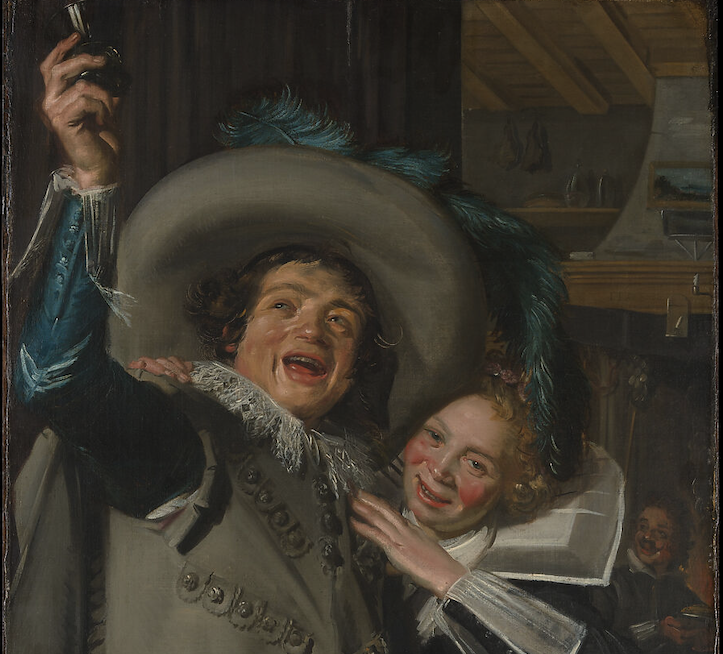The Frans Hals Code

No Albino priests were killed, and no bizarre rituals were performed; an uncle and niece just took a look at what has been hidden in plain sight.

Uncle Ed began: “Wine is a symbol, it has to be a symbol. It represents something else. In the ancient world, when people drank wine, it elevated their experience. It made them feel more social, forgiving, joyous. They felt one with their community. Wine softened and united people. It looked a little like blood and seemed to lift them through mysterious means to a higher, more ethereal, level of being which put ordinary life to shame.
“Also, grape juice is naturally fermenting – you crush grapes and leave the juice lying around and it naturally turns to wine. This blew the minds of ancient folks who didn’t know anything about yeast cells floating around in the air. The very self-production of wine from crushed grapes seemed to be a gift from the gods to elevate our mood and increase our pro-social characteristics. So they crushed grapes, put the juice in cisterns, buried the cisterns, and then when they dug the stuff up, it’s this potent concoction that makes human life better.
“So you get a type of death and resurrection story there too. You get wine as a symbol of a type of ‘new life’ born of the crushing of an older, less exciting life. You get a life that can be characterized by mercy instead of harsh justice, love instead of hate, forgiveness instead of revenge, altruism instead of egoism, and all that good jazz. Because wine mysteriously changes attitudes, it becomes a symbol for a possible type of higher or better life – a new life to shoot for.”
“So what about this painting?” Irene queried.
“Look at it. It almost broadcasts that it is an allegory. In the lower-left section, the guy holds a dog’s snout, and when you run your eyes upward, diagonally, you see him holding some type of alcoholic beverage way in the air. Here’s my interpretation, take it or leave it: The dog represents our ‘animal’ or ‘lower’ nature. I mean, why stick a dog in this painting in an inn? Why hold the dog by the snout? Have you ever held a dog by the snout? Of course not. There’s probably a reason he’s got a dog here, right, and a reason he’s holding it in a peculiar way? No?”
“OK, I’ll go with that,” Irene said.
“So by our ‘animal’ or ‘lower’ nature, I mean that these are all the emotions and motives and predispositions we are born with or pick up somehow against our will – maybe the negative or the potentially anti-social emotions involving anger, hatred, revenge, bitterness, jealousy, all that stuff. All the harmful emotions we allow to guide our lives without even trying to understand or regulate them: all the fixed-action patterns and ‘normal’ ways that we respond, which can be harmful to us or others or which cause more harm than good. This is our ‘dog’ or animal nature. This is literally shown in the lower left corner of the painting.
“In the upper right corner he victoriously holds his wine or brandy or whatever it is. The painting, to me, seems to be tracing a possible type of humane development which, I tend to believe, is the core of the teachings of Jesus, if you look at that story as an allegory and not as if it really happened.”
“But is any type of booze going to work as a symbol here, or does the booze have to be wine? I’m not exactly sure that’s red wine up there, Ed. Gotta be honest.”
“You have to remember that wine was the most potent drink in the ancient world. Distillation of more powerful spirits didn’t happen until after all the myths and stories had been created, not until about the 900s in our current age, and this happened in the Middle East. So even if we’re talking about brandy or some other potent potable, it still works symbolically. He’s holding a dog’s snout to the lower left and some type of alcoholic drink to his upper right. And look at this guy’s face – pure joy. He is now liberated, free, ecstatic. God, I love Franz Hals.”
“Why throw the woman in there?” Irene asked.
“Good point. A good interpretation explains everything, not just some stuff. In ancient religious and literary traditions, the union of male and female or the masculine and feminine was symbolically meaningful. The male represented a type of ‘desire’ for a better or higher life and the woman represented the ‘fulfillment’ of that desire. We’ve got all kinds of stories of wandering men returning to their faithful women: Odysseus and Penelope is one. Rama and Sita is another. Prince Tamino and Princess Pamina. Remember that Jesus turns water into wine at a wedding where the male and female are united. You’ve got all kinds of symbols representing this union of the masculine (desire) and feminine (fulfillment) – like yin and yang or the Star of David which is the union of the Sumerian upward pointing triangle (masculine) and the downward pointing triangle (female).
“Going back to the Hals painting, the imaginary line from the dog’s snout to the glass of booze is, basically, the hypotenuse of a right triangle. Among the ancient Pythagoreans, the hypotenuse represented a new birth. The horizontal line of the triangle was the female, the vertical line was the masculine and the hypotenuse was ‘born’ of these two elements. The hypotenuse represents a new life and Hals possibly puts that into this painting. At least that’s how I see it. Is it a coincidence you’ve got a hypotenuse here? It’s a hypotenuse.”
“Ed, I don’t want to rain on your parade, but I have a guidebook here where established, respected and unbiased art scholars say the dog represents spontaneous emotion.”
Ed flipped out a bit. “What the…phlogiston!” He was quite perturbed.
“How the heck do you get spontaneous emotion from the dog in this painting?”
People were starting to look at him. “Sir,” he looked at a tourist.
“Does this dog represent spontaneous emotion to you?”
The fellow took a closer look and said, “No. It’s just a dog standing there with a guy holding its snout for no reason.” Ed nodded as the man wandered away.
“This is what ticks me off about some interpretations.” Ed continued. “They are supposed to be parsimonious – explaining the most with the least – and not just random guesses. Total phlogiston. My interpretation is more parsimonious and more thoughtful and more meaningful to me. You have several
elements in this painting that have to be explained to get a good, thorough interpretation. Saying this is a painting about spontaneous emotion is giving up too quickly and not putting enough effort or thought into it. Mine is better. Wow, I am so ticked off now by those established, respected and unbiased scholars.
“I mean, you’ve got lots of things to explain here. Why the dog? Why is this dog apparently in a public tavern? Who holds a dog by the snout? Why the woman? Why is the guy holding the dog’s snout while raising a glass of spirits? You could even ask, why is he holding the dog’s snout with his left hand? Once, a professor of mine who was Native American and teaching a course on Native American religion
threw a piece of chalk at me. I grabbed it before it hit me and he said, ‘Which hand did you use to grab that piece of chalk?’ I replied that I had used my left hand. He then asked me what I thought the left hand might represent in some Native American religions. It dawned on me, ‘Oh, receptivity. The left hand generally receives while the right hand is usually the hand of action or effort.’
“I mean, how the heck does this dog represent spontaneous emotion? Look at that dog – there’s nothing spontaneous about it, it’s just tamely standing there. The dog has been tamed and the guy is celebrating with the spirits raised in his other hand. He controls the friggin’ dog and is ready to get stinking, rip-roaring drunk, and goddarn it he should get rip-roaring drunk because it’s mad hard to get control of that friggin’ dog! Oh my God we have to dig deeper and try harder with our interpretations!.”
“OK,” Irene said, “But the big question would seem to be about how we get from that dog to that wine. No?”
“Amazing point,” he said. “That’s the million-dollar question. First, does this process really exist and how does it work and how does a person get from the dog to the wine? Wine or spirits would seem to represent a consummation of a process of development, and there are other symbols and other allegories that concern the process that might be involved in getting to this type of ‘higher’ order life. We saw Parsifal at the Met Opera a while ago; that whole opera seems to be about this type of process.”
“So Ed, your buddy Hals kind of leaves out how that dog got tamed and where the guy got his booze from.” Irene offered.
“That’s fine. You’ve got all kinds of traditional symbols all over the place: thieves, stone, ravens, water, the sun and moon, battle, horses, bulls, fasting, sons avenging fathers, good men marrying rotten women, rotten men marrying good women, the desert…shoot, even gender has a symbolic meaning, as I pointed out just now. There are lots of symbols and stories concerning the process of getting to the wine. A certain process has been described symbolically in regard to reaching this type of life represented by wine and living as humanely as possible.
“But you know,” Ed continued, “If we’re looking for specific types or a specific type of inner emotional state that wine might represent, I think it could represent what some ancient Greek philosophers called ‘ataraxia’ – unperturbedness. One analog of what wine might mean to us could be the development of a capacity not to be swept away so easily emotionally by the emotions or actions of others, especially in regard to how we respond to malicious emotions or callous or harmful actions of others.
“There’s a certain sense of injustice a lot of us perceive in regard to our own emotional states or reactions. If someone insults me or reproaches me or is rotten to me, why should I be so adversely or painfully affected emotionally? It just seems wrong that others should be able to drag me down so easily. Why do I automatically rise to the level of nastiness and aggression others project at me? I’m guessing that if you are confronted by a violent or aggressive person the emotions we developed through natural selection prompt you to rise to that competitive level for our own survival value.
“The irony is that if a person refrains from rising to that level, he’ll probably live longer. If you rise to someone else’s level of aggression, you had better be a better fighter than he is. Also, a lot of flawed people are modeling lots of flawed behavior for us every day. We don’t have to become so indignant or angry or even violent after we feel frustrated or offended. We can choose something else.”
Uncle Ed and Irene moved to the next painting.

Daniel Gauss is a graduate of the University of Wisconsin and Columbia University. He has been published on numerous platforms dealing with art and culture and has been working in the field of education for over 20 years. He currently teaches in Shenzhen, China.
Photo: Young Man and Woman at an Inn, from the Metropolitan Museum
